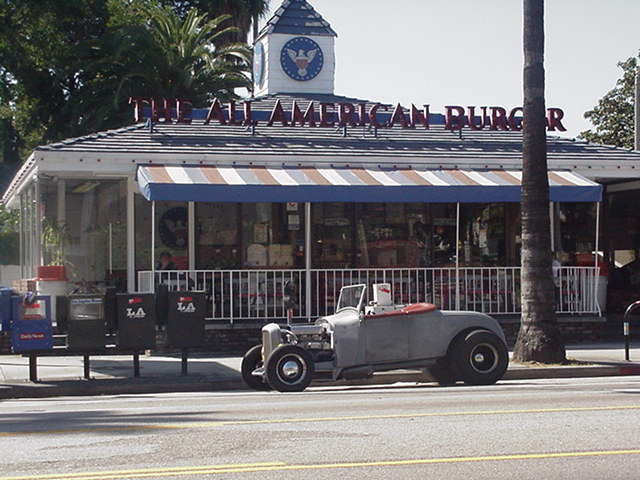Topic: The Culture
Is it time to eschew Roland Barthes for the Marxist critic Walter Benjamin?
I have mentioned before - and Ric added visuals too - the fellow who reviews news cars in The Los Angeles Times, Dan Neil, who recently won the Pulitzer Prize for criticism, the first automotive writer to ever win that. See What would Roland Barthes drive? from Volume 2, Number 8 of Just Above Sunset Magazine, Monday, February 23, 2004 - where he was introduced.
Well, Dan Neil is at it again.
Today in The Los Angeles Times he eschews Roland Barthes for the Marxist critic Walter Benjamin. Really. He does.
The item, once you get past the extensive registration, is this:
One is unique, two is too many
Concept cars such as the Chevy SSR are defined by individuality, a quality lost on the assembly line.
Dan Neil, Los Angeles Times Staff Writer, April 21, 2004
Neil is reviewing the new Chevrolet SSR - which is a imitation hot rod pickup truck, with a folding metal convertible roof and "retro" styling and fat tires, a sort of cartoon car, the kind of thing boys draw in the eighth grade when they're bored. It's quite odd. It started out as a "concept car" and the Chevy people actually decided to build the thing.
But who cares? The fun is in the ironic cultural warps Neil goes through - like this:
Well, no point in discussing the car (truck) here. It's heavy and sluggish and crude, and quite expensive. Neil covers all that.The most lucid thing the Marxist critic Walter Benjamin ever wrote is the essay "The Work of Art in the Age of Mechanical Reproduction," written in 1936, during an apparent dry spell in Berlin's hashish supply.
Benjamin's famous essay, a staple of film-lit classes, puts a dope-scented finger on a central issue in aesthetics: If the art object is special -- if it has an authenticity, an "aura," Benjamin calls it -- what is the status of the duplicate, the mechanically reproduced copy?
"That which withers in the age of mechanical reproduction is the aura of the work of art," says Benjamin. Reproduction "substitutes a plurality of copies for a unique existence."
In other words: The first David by Michelangelo is art, the second is a lawn ornament.
Which brings us to the Chevrolet SSR. The SSR -- Super Sport Roadster, if you must know -- began life as one of those impossibly cool concept cars at the 2000 Detroit Auto Show, a pickup truck gene-spliced with a hot-rod roadster and incubated in gorgeous '50s heritage, with brand cues skimmed from the noses of Chevy trucks circa 1947-'53.
Roadster? Pickup? Retro? PoMo? No one knew quite what to call it -- and resorted to calling it everything at once -- and GM didn't have a very good idea how to build it....
In doing so he does get off some good lines. In discussing the folly of mass producing cars folks loved as "concepts" at the auto shows, Neil points out one might do better not to, and the manufacturers sometimes know it:
And they didn't build it. Perhaps they anticipated the lawsuits from the families of recently flattened peasants.Just about every carmaker I can think of has been burned by this phenomenon at one time or another. They display a show-stopping prototype -- for example, the Plymouth Prowler -- and the car-loving public begs the automaker to bring the car to market; but by the time the finished product rolls off the assembly line, the vehicle isn't so cool anymore. Art has become commodity. Elvis has left the building.
Nobody understands the risks better than the carmakers themselves. GM's Cadillac Sixteen was the darling of last year's autoramas -- a huge, rakish and evocative 16-cylinder saloon car, as sumptuous a slice of autocratic hauteur as ever ran over a peasant. Build it and they will come, chorused the automotive press. Yeah, sure, right, said GM.
But they built this SSR thing. And it's just silly. And as Neil says -
Yes, corporations can't build hot rods.It's also too expensive. Our test model, in crime-scene-tape yellow, was priced at $44,260, a price point that limits its appeal to -- if I may be so indelicate -- rich old guys who want yet another weekend toy.
And a toy is just what it looks like, something the Revell model company might require you to glue together over a weekend. It's the sort of vehicle that will stop preschoolers in their tracks, but the older the observer -- if one can judge from the looks on their faces -- the more mixed the reactions. There is a lack of seriousness with the SSR -- a lack, Benjamin would say, of authenticity. And I felt kind of ridiculous behind the wheel.
And that circles back to the Marxist critic Walter Benjamin -
Yep, it's not the real thing. It will not do, as it is not the thing in and of itself. It may have been designed out here at the GM design center in Pomona, just east of Los Angeles, but it's not the real deal, just a corporate marketing object, a brick on wheels.By definition, hot rods are one of a kind. And when we see them on the street we light up because we are in the presence of something special, art qua art. Also, hot rods are built from the inside out. They are old cars with their guts ripped out so they can get as much performance as possible under the hood. Pouring a racy enamel over a truck chassis just isn't the same.
The concept-car SSR was as close to the real thing as it will ever get. When I look at an SSR on the street now I see only a copy of an original. It's as if it were forever and futilely swimming upstream toward its spawning grounds, the auto show floor, to the time and place where it was unique.
The SSR's greatest failing is not that it's a novelty but that it's not novel enough.
Here's a real California hot rod, on Sunset Boulevard, at the appropriate business.

Posted by Alan at 17:56 PDT
|
Post Comment |
Permalink
home



